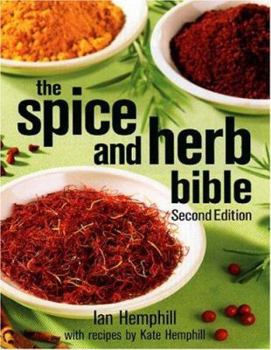The Spice and Herb Bible
Select Format
Select Condition 
Book Overview
The new edition of the IACP-award-winning book on spice. Cooks everywhere use spices and herbs to enhance food flavors and to create new taste combinations and sensations. From bay leaves to... This description may be from another edition of this product.
Format:Paperback
Language:English
ISBN:0778801462
ISBN13:9780778801467
Release Date:March 2006
Publisher:Robert Rose
Length:606 Pages
Weight:3.25 lbs.
Dimensions:1.0" x 7.0" x 10.0"
Customer Reviews
4 ratings
well organized and very useful
Published by Thriftbooks.com User , 16 years ago
I purchased this book a few years ago. Even after numerous readings, I refer back to it constantly. The organization of the book makes it a compact volume considering its informational density. The exhaustive list of herbs and spices is arranged alphabetically. Each entry features a brief botanical overview followed by a history, a description of cultivation/processing, what to look for when buying and how to store the spice/herb as well as a bit about its use, including recipes in many cases. There are very clear photos, each clearly labelled. The real treat is the margin notes. Each spice/herb has notes detailing: common names, botanical names and family, common names in languages other than English, weight per tsp, flavour group (i.e., hot, sweet ,bitter, etc.), suggested quantity per lb of red meat/white meat/vegetables/carbs, a list of other spices/herbs the subject compliments and finally, a list of common applications. This is a very dense book!! It continues to be one of my favourites. Each time I research a new recipe or cooking method, I consult this book.
A must-have book in every kitchen...
Published by Thriftbooks.com User , 18 years ago
Ian Hemphill's excellent book truly takes the guesswork out of adding herbs and spices to all recipes. Not only does the book feature an impressive and detailed list of herbs and spices, including growing and storage tips, each entry also makes suggestions for combining a particular herb/spice with others, what foods these would complement etc....An interesting and valuable resource book, should be in every cookbook library.
Lots of interesting and useful information, but not the best.
Published by Thriftbooks.com User , 18 years ago
`The Spice and Herb Bible' by Australian spice merchant, Ian Hemphill, published by Canadian culinary `bible' publishing specialist, Robert Rose is a serious entry to be one's definitive reference for spices and herbs, but it fails largely because of the strength of its competition and from the fact that it is not as cook friendly as its subtitle, `A Cook's Guide' may make you believe. My choice for first and second place among good books on kitchen seasonings are `The Contemporary Encyclopedia of herbs & spices' by Seattle spice merchant Tony Hill and perennial culinary expert, Jill Norman's `herbs & spices, the cook's reference'. While these books are very different from one another, they are both superior to Hemphill's book as a reference to the average home cook. Oddly enough, this book may actually be the best of the three as a reference for the aspiring spice merchant. The first thing that made me wary of Hemphill's book was its very choppy and anecdotal history of the spice trade. It hit only the most interesting highlights, and got several facts wrong in the process. The two most serious errors may have been ascribing the military expansion of Islam to the prophet Mohammed personally and by ascribing to the inaccurate and largely discredited doctrine that the European use of spices was to mask poorly preserved meat. In fact, meat preservation technology (charcuterie) was really very highly developed by post-Roman Europe. There is no question that Hemphill gives us oodles of good information about herbs and spices, but unlike Norman's very cleverly organized book, this information is practically useless for the cook who happens to want to use an herb or spice in a dish and wishes to find an appropriate selection, when she knows she wants a hint of licorice flavor in a fresh herb, but her local megamart is all out of her known sources of anise flavorings. If it were not for the historical gaffs in the historical overview and the fact that Hemphill puts all of his entries under the rubric of `spices' rather than splitting them up by herb and spice (like Norman), or at least identifying the dictionary section as `Herbs and Spices' (like Hill). Each entry does look like a guide for the merchant or scholar rather than the cook. It includes: Common Name Other Common Name(s) Botanical Name, i.e. genus and species Botanical Family (genuses belong to families in the Linnean classification scheme) Names in other languages (a la Bruce Cost's excellent `Asian Ingredients') Flavor Group - This is a means of organizing seasonings which Hemphill may have contrived himself. At the very least, it is not broadly used and does not correspond to the familiar four or five tastes on the tongue. Weight per Teaspoon - A means of converting weights to volumes for shredded, ground, or finely chopped seasonings. The usefulness of this material escapes me. Suggested quantity per pound - A similarly arcane fact that I doubt any professional chef would ever us
Worthy of any home library
Published by Thriftbooks.com User , 21 years ago
Cooks use spices and herbs to enhance flavors and create new ones: Spice And Herb Bible provides a reference and a history, describing a range of global herbs and spices that can be used in modern kitchens. The a-z reference allows for quick, easy look-up of ingredients. While an index of herb and spice sources would have helped those without a shop at hand, this reference still packs in essential details and is worthy of any home library.





